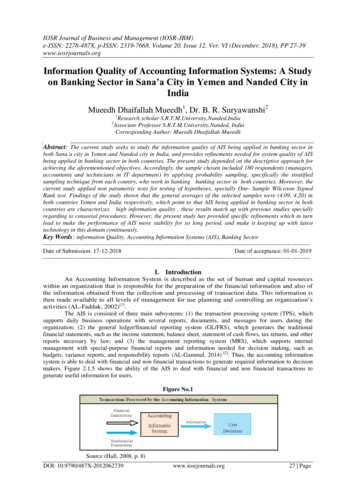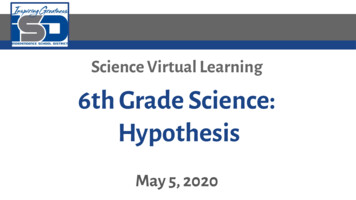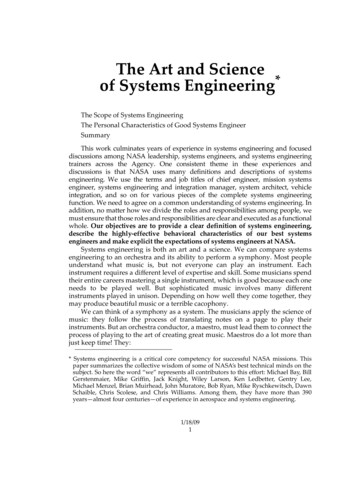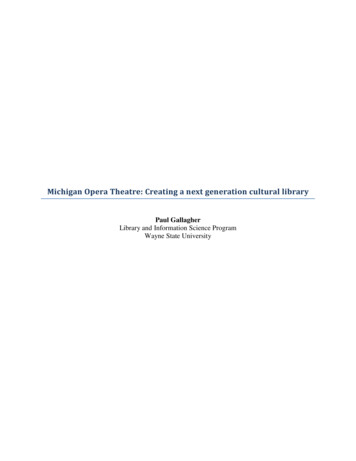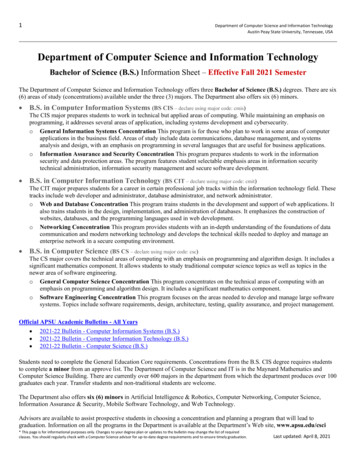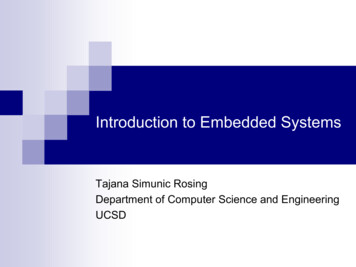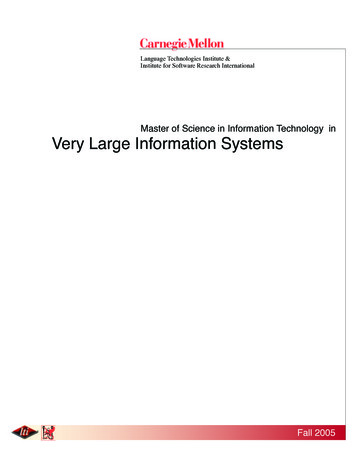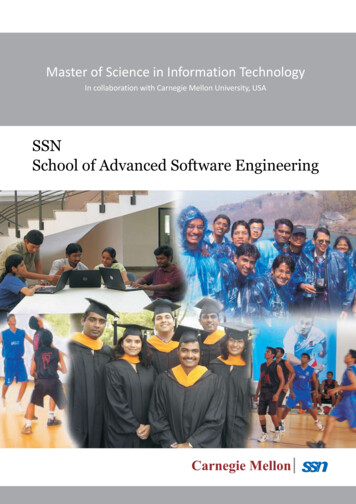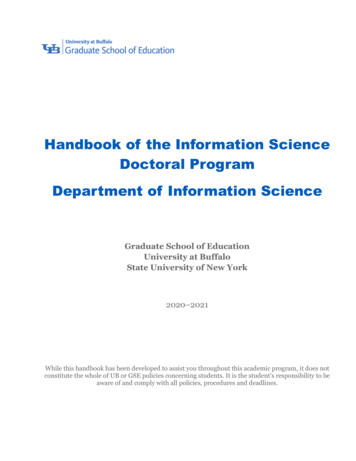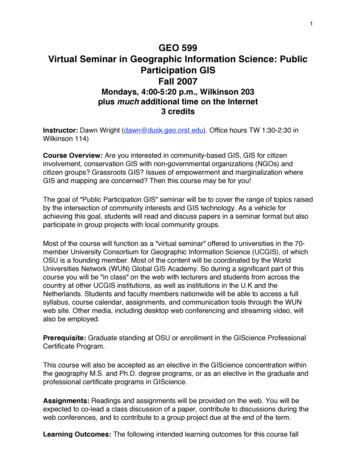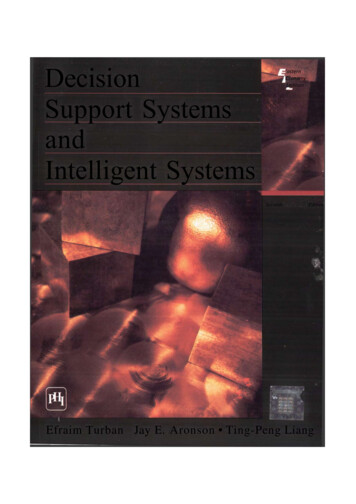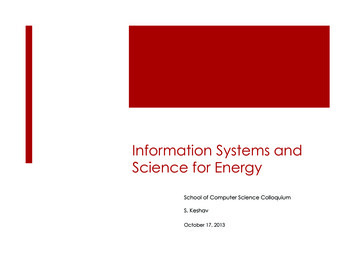
Transcription
Information Systems andScience for EnergySchool of Computer Science ColloquiumS. KeshavOctober 17, 2013
IPCC Report: 27 Sep 2013! Warming of the climate system is unequivocal
Gasoline combustion1 liter of gasoline 2.27kg of CO2
Electricity generation Transportation!IPCC 2007
Today’s Electrical Grid
!"3 components! !"#" %&'#(! ) %#* ,**,'#(! -,*. ,/0&'#(((
Howstuffworks.com
Grid characteristics
#"1. Overprovisioned by design((capacity
2. Inefficient5% better efficiency of US grid zero emission from 53 million carshttp://www.oe.energy.gov/
3. AgingPost-war infrastructure isreaching EOL
4. UnevenTWh generatedDaily W/capita (2012 est.)! China4,938395! US4,2561402Wikipedia
5. Poorly measured
6. Poorly controlled! Electrons are not addressible
7. Ridiculously cheapWikipedia
Technology is changing the grid
1. WindWIND POWER CENTS/KILOWATTHOUR*/45"--&% 8*/% "1" *5: (8INSTALLED CAPACITY (GW)“Revolution Now,” US DOE Sept. 17. 2013
2. SolarModule cost /WDeployment MW“Revolution Now,” US DOE Sept. 17. 2013
The future is here now!60%! Wind and solar produced 60% of Germany’selectricity on October 3Image: BCCONSULT
3. Storage: the holy grail! Global investment in energy storage technologies to reach 122 Billion by 2021: Pike Research! Many new technologies! Batteries! Flywheels! Supercapacitors! Compressed air storage
4. Electric vehicles! Spur research on lower-cost storage! Huge consumers of electricityNissan Leaf chassis
5. Pervasive sensingMichigan Micro Mote
6. Pervasive computationFreescale KL02 microcontroller 1.9 mm x 2.0 mm
7. Pervasive communicationTrilliant Corp.
8. Pervasive controlControl 4’s EMS-100 in-home display
Current grid“Smart” gridCentralized ! DecentralizedLittle to no storage ! Storage richHigh carbon ! Renewables/low carbonPoorly measured ! Sensing richPoorly controlled ! Control richOssified ! FlexibleInefficient ! Energy frugal
OK, we’re done, right?
Maybe not
1. Matching demand and supply'SPN #BSOIBSU FU BM 1SPD &OFSHZ BOE &OWJSPO 4DJ 7 QQ Barnhart et al, Proc. Energy and Environment, 6:2804, 2013
2. Storage is expensive! Buying 1 KWh 10c! Storing 1 KWh 450!
3. Controlling distributed generatorsUS EIA
4. Control over many time scalesJeff Taft, Cisco
5. Communication is complexReference ModelTrans-Regional Balancing Org.Synchronous Grid Inter-Tie ControlTrans-Regional Energy MarketsTrans-Regional NetworksWide Area Monitoring and Control System (WAMCS) NetworksInterchange Authority/Reliability CoordinatorGrid Direct Current (DC) Inter-TiesBalancing AuthorityOther Region PhasorMeasurement Unit(PMU) DataInterchange TierOther Balancing AuthoritiesArea ControlError (ACE)ControlVirtual Power Plant (VPP)/Demand Response (DR)ApplicationOther Energy TradersVPP/DRApplicationACEControlControl Area NetworksUtility EnergyTradingConventionalWindSolar Customers Suppliers Retail EnergyProviders (REP) Third PartiesOther TransmissionSystem Operators (TSO)/Distribution SystemOperators (DSO) and VerticalsEnterprise NetworksData CenterEnterpriseApplicationsand UsersData CenterNetworkCallCenterControl CenterApplicationsand UsersControl CenterControl CenterFieldDispatchControl CenterNetworkIntra-Substation NetworksPhasorMeasurementUnit (PMU)DistributionSubstationIntra-Substation NetworksSystem Control tributionPMUIntra-Substation NetworksSubstation TierIntra-Substation NetworksDistribution LevelStabilizationSensor NetworksTransmission LevelStabilizationIntra-Control/Data Center TierControl CenterNetworkInter-Substation ucers(IPP)Utility TierInter-Control Center NetworksTransmission PMU DataTractionSubstationBalancing TierStorageThird PartyStabilizationServicesWeb PortalsUtilityNOCOther RegionsInterchange NetworksWAMCS NetworkOperations Center (NOC)/Data CenterOther TSOPMU DataTrans-Regional/Trans-National TierWholesale Energy MarketsVPP/DR Data/SignalsSensor Networks(DSTATCOM)Urban FANsRural FANsNeighborhood Area Networks (NAN)(Residential, Commercial and Industrial)D Level 1 TierDistribution Automation (DA)Sub-networksStreetlight SystemsElectric Vehicle (EV)Sub-networksConverged Voice,Data, and VideoThird Party Aggregatorof DR, DistributedGeneration (DG), etc.Volt/ VAR RegulationDA DevicesD Level 2 TierFault Isolation and ServiceRestoration NetsSensor SubsystemsLine SensorDistributedDistribute EnergyResourc (DER)Resources(large scale)InternetFeederD-PMUNetsGatewayResidential NetworksHome Energy ControllerControlsBuilding NetworksInverter ControlInDER ProtectionDPrivate Microgrid NetworksSensorsProtection and ControlControlsInverter ControlIn-Vehicle NetworksProsumer TierChargerMeterInverter ControlDisplays 2011 Cisco and the Cisco Logo are trademarks of Cisco and/or its affiliates in the U.S. and other countries. A listing of Cisco’s trademarks can be found at www.cisco.com/go/trademarks. Third-party trademarks mentioned are the property of their respective owners. The use of the word partner does not imply apartnership relationship between Cisco and any other company. (1009R)C82-676734 6/11Cisco
6. Consumers have no incentive tosave! Energy savings of 10%! 10/month
7. Utilities have no incentive to save!
ISS4E
MissionTo use information systems and science to! increase the efficiency! reduce the carbon footprintof energy systems
3 Approaches1. Exploiting equivalency of grid and Internet*2. Problem-oriented research3. Data-driven research** novel
1. Grid InternetS. Keshav and C. Rosenberg, How Internet Concepts and Technologies Can Help Green and Smarten the Electrical Grid,CCR, January 2011.
GridInternetElectrons BitsLoad SourceCommunication link Transmission lineBattery/energy store BufferDemand response Congestion controlTransmission network Tier 1 ISPDistribution network Tier 2/3 ISPStochastic generator Variable bit rate source
Equivalence Server(C)LnEvery trajectory on the LHS has an equivalent on the RHS can use teletraffic theory to study transformer sizingO. Ardakanian, S. Keshav, and C. Rosenberg.!On the Use of Teletraffic Theory in Power Distribution Systems, e-Energy ’12.
A. Guidelines for transformer sizingHydroOne’s guidelinesPrediction from teletraffic theoryCan also quantify impact of storageO. Ardakanian, S. Keshav, and C. Rosenberg.!On the Use of Teletraffic Theory in Power Distribution Systems, e-Energy ’12.
!"# %&'("%)'* ,'-. "/%0123"* '12%012 ,1 %41,%5 "6 ,'6# %7"8'6 "%08#,3'23%B. TCPfor EV charging9(#, %:,'/%;,68' "6 .,"%%! 1 EV 5 homes! Creates hotspots! Real-time AIMD control ofEV charging rate! Solution is both fair andefficient %O. Ardakanian, C. Rosenberg and, S. Keshav, “Distributed Control of Electric Vehicle Charging”. e-Energy ’13
C. Matching supply and demand'SPN #BSOIBSU FU BM 1SPD &OFSHZ BOE &OWJSPO 4DJ 7 QQ
“Rainbarrel” modeluncontrolledstochastic inputrangeWhat barrel size to avoidoverflow and underflow“with high probability”?uncontrolledstochastic output
Envelope idealower envelope " Σinput " upper envelopeEnvelopes are computed froma dataset of trajectorieslower envelope " Σ output " upper envelope
Stochastic envelopesP((Σinput - lower envelope) x) ae-xP((upper envelope –Σinput) x) be-x
Stochastic network calculusEquivalenceWang, Kai, et al. "A stochastic power network calculus for integrating renewable energy sources into the power grid.”Selected Areas in Communications, IEEE Journal on 30.6 (2012): 1037-1048.
Analytic results! Minimizing storage size to smooth solar/wind sources! Optimal participation of a solar or wind farm in dayahead energy markets*! Modeling of imperfect storage devices*! Optimal operation of diesel generators to deal withpower cuts in developing countries*Joint work with Y. Ghiassi-Farrokhfal, S. Singla, and C. Rosenberg
2. Problem-oriented researchIncrease efficiency, reduce carbon New technologies! Storage! EVs! Pervasive computation,sensing! Renewable generationDesignOptimizationQueueing theoryNetwork calculusControl theoryNetwork flowAlgorithmsImplementation!DataEvaluation
Smart Personal Thermal ComfortReduce building energy use with fine-grained thermal control ofindividual officesP.X. Gao and S. Keshav, Optimal Personal Comfort Management Using SPOT , Proc. BuildSys Workshop, 2013.P. X. Gao and S. Keshav, SPOT: A Smart Personalized Office Thermal Control System, Proc. ACM e-Energy 2013, May 2013.
Our insight
In a nutshell! Mathematical comfort model! When occupied, reduce comfort to the minimum acceptablelevel! When vacant, turn heating off! Optimal model-predictivecontrolTemperature! Pre-heat26252423222120Occupancy6 7 8 9 10 11 12 13 14 15 16 17 18Time of a day
New technology: sensing51(,#2 % "3(*"#*' Servos901(,#2 % "3(*"#*' Microsoft KinectMicrocontrollerWeatherduck *"#*'
Evaluation: clothing level estimation! Root mean square error (RMSE) 0.0918! Linear correlation 0.92
New technology: data mining foroccupancy prediction! Predict occupancy using historical data0 .3 1 1 1 .3Matchprevious similarhistoryPredict usingmatchedrecords
Comparision of schemes!"# %&#'(%)* ',-# & './012' " ,-./012./34./5.617,8.9:.; 5.617,8.9 ? 7,;64 !#"#!"!!%&!%"!%'!%(!%)!"# %&#'!345*67#'889'Discomfort!%*
3. Data-driven Effect of new technologies! Storage! EVs! Pervasive computation! Renewable generationAnalysis!!!!!Data miningMachine learningBig data analyticsWhat-if analysisSimulationInsights
Problempeakaverage
What we’d likepeakaverage
New technology! 5 million ‘smart meters’ installed in Ontario
Ontario Time-Of-Use (TOU) Schemeoff-peakmid-peakpeak
Questions! Is 2 the right number of seasons?! Should they be 6 months long?! Do they start at the right times?! Do peak times correspond to load peaks?! Does the scheme reduce peak loads?A. Adepetu, E. Rezaei, D. Lizotte, and S. Keshav!Critiquing Time-Of-Use Pricing in Ontario, IEEE SmartGridComm Symposium 2013, Vancouver, October 2013.
Dataset! Aggregate hourly energy use in Ontario for the last 10yearsAggregate Ontario load for the first two weeks of May over 4 years
Answers! Is 2 the right number of seasons? No! Should they be 6 months long? No! Do they start at the right times? No! Do peak times correspond to load peaks? No! Does the scheme reduce peak loads? No!A. Adepetu, E. Rezaei, D. Lizotte, and S. Keshav!Critiquing Time-Of-Use Pricing in Ontario, IEEE SmartGridComm Symposium 2013, Vancouver, October 2013.
A better scheme4 seasonsSummerFallWinterSpringA. Adepetu, E. Rezaei, D. Lizotte, and S. Keshav!Critiquing Time-Of-Use Pricing in Ontario, IEEE SmartGridComm Symposium 2013, Vancouver, October 2013.
Other datasets! Hourly electrical load from 26,000 homes in Ontario! Hourly electrical load from 5,000 homes in Ireland! Hourly water usage from 27,000 homes in Abbotsford! Per-appliance energy use for 500 appliances! 50 commercial buildings’ energy use over 2-4 years (Pulse)! 500 taxi driving records for 1 month (Cabspotting)! 7 years of car rental records (Grand River Carshare)! Hourly electricity prices and use for 10 years (IESO)! Solar and wind production over 10 years (NREL)! Weather records (Ontario)
Reflections on the research area
Energy researchProsCons! Rapidly growing researcharea! Requires learning newconcepts and ideas! Many open problems! Entrenched interests! Industry interest and support! Difficult to obtain data! Motivated students! Field trials nearly impossible! Potential for impact
Many open research problems! Renewable integration! Multi-level control! Non-cash incentive design for consumers! Energy efficiency policies for utilities! Storage size minimization in energy systems! Incentives for EV adoption! Data mining of energy data sets! Peak load reduction! HCI for energy applications! Data center energy minimization! Microgrid/nanogrid design! Building energy use monitoring and reduction
Join us!! ISS4E mailing list! ISS4E seminar series starting October 2013! next speaker: Pascal van Hentenryck, 4pm onOct. 24th! Open weekly group meetings, 10:30-11:30on Wednesdays in DC 1331
Conclusions! Technology is changing the grid! Computer Science has a role to play! Opportunity for interesting, impactfulresearch
Acknowledgements
ISS4E FacultyCo-DirectorAffiliated facultyCo-authors
ISS4E students
WISE! Prof. Jatin Nathwani (Executive Director)! Tracey Forrest (Director)! Prof. Claudio Canizares (ECE)! Prof. Kankar Bhattacharya (ECE)
Funding agencies
Corporate sponsors
Our next project
Backup slides
What kills birds?! According to Environment Canada! Wind turbines: 16,700! High-rise buildings: 64,000! Single family homes and low-rises: 22,000,000! Cats: cats-blamed-for-70-of-bird-deaths-in-canada-study/
Impacts! Physical! Extreme weather! Ocean acidification! Sea level rise! Ocean currents! Social! Food supply! Water availability! Health! Ecological! Species loss! MigrationWikipedia
Carbon emittersWikipedia
Top emittersWikipedia
Per capita carbon emissionsWorldBank
Renewableenergy
Pervasive communicationTrilliant Corp.
Storage“Bytes”“Bits/s”
Solar SSPE80007000Ig(t) (Wh/m2)6000sample pathProbabsilitic envelopeMean rate envelopeBound on samples50004000300020001000012345time (hour)678! Model stochastic sources (solar, wind) and stochastic loadsusing Markov models or stochastic sample path envelopes
Pervasive communication
Carbon from gasoline combustion! 2C8H18 25O2 - 16CO2 18H20C9H20 14O2 - 9CO2 10H202C10H22 31O2 - 20CO2 22H20C11H24 17O2 - 11CO2 12H202C6H6 15O2 - 12CO2 6H20C7H8 9O2- 7CO2 4H204C8H7 39O2 - 32CO2 7H202C8H10 21O2 - 16CO2 10H2O! 1 liter of gasoline ( 800g) produces2.27kg of CO2
Ontario Time-Of-Use (TOU) Scheme94
Publication venuesConferences andworkshopsJournals! eEnergy! IEEE Trans. Smart Grid! SmartGridComm! IEEE PES magazine! Buildsys! Energy and Buildings! GreenMetrics! J. Solar Power! ACM Sustainability! J. Power Sources! AAAI: Sustainability track! Transportation! AAMAS
partnership relationship between Cisco and any other company. (1009R) C82-676734 6/11 Distribution Level Stabilization (DSTATCOM) Neighborhood Area Networks (NAN) (Residential, Commercial and Industrial) Residential Networks Building Networks Private Microgrid
